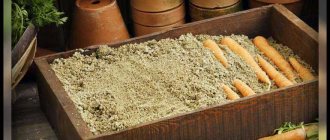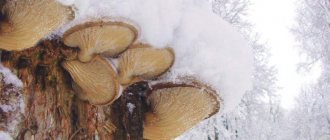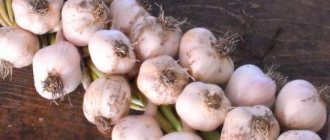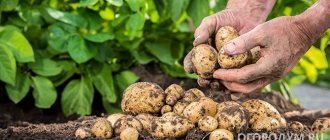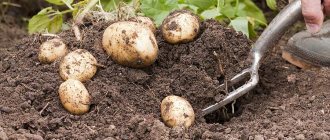The cellar was originally invented as a room in which crops are stored. Accordingly, the temperature in such a room should be cool both in summer and winter, while freezing of the basement is not allowed.
What temperature indicators in the cellar are optimal, as well as how to achieve the ideal balance, not forgetting about humidity values, every cellar owner should know. What temperature should be in the cellar depends on its purpose.
Optimal temperature
Ideally, in order for the cellar to maintain its functionality, the temperature should be 2-4 degrees above zero. This is the optimal temperature in the cellar, both for preserving fresh produce and for pickles. However, deviations from the norm are allowed during the hot period of the year.
The temperature in the cellar in summer can exceed the optimal values by three degrees, but no more. In this case, whether it is warm or cold in the cellar depends not only on the indicators outside, but also on the presence of thermal insulation, ventilation, the depth of the cellar and the level of humidity in the basement. To create the best temperature indicators, you must first of all build the room correctly.
Firstly, it is very difficult to maintain normal temperature in a cellar dug in clay soil. It will require additional thermal insulation materials. An excellent option for building a cellar is sandy soil, as well as sandy loam soil. Secondly, the presence of forced ventilation is mandatory. It will be able to ensure normal temperature in the basement even in winter. It is much more effective than the natural option.
In any case, to support ventilation, you can open the door more often during the hot season. Sometimes for ventilation it is enough to simply build a few holes in the foundation. During the cold season, it is not recommended to open the cellar for a long time.
You can check whether the ventilation system is working properly using a candle or lighter. If the flame sways, it means there is a hood. In addition, poor ventilation of the room is immediately visible by the appearance of mold, as well as a characteristic musty smell in the room.
It is important to understand that the basement, which is located under the house, affects the entire structure of the house with its microclimate. How many degrees the temperature should be for a particular cellar depends on its purpose. For example, a wine cellar requires slightly higher values.
Parameters influencing the norms
Geological
When choosing a location for a cellar, it is necessary to take into account the geology of the area and climatic conditions. The temperature characteristics and moisture level in the cellar are in full accordance with the characteristics of atmospheric air. Initially, what people pay attention to is the type of soil in which the basement is supposed to be built.
- In soils of high density, heat is transferred quite easily. For example, clay soils are considered good heat conductors. This is fraught with food freezing in winter and heating in summer. Therefore, very high-quality heat insulators are additionally used.
- Sandy loam and sandy soils are unimportant heat conductors, therefore, in structures that are built in them, temperature indicators will almost always be stable. No additional thermal insulation work is required.
Humidity level
To maintain a good microclimate in the basement, it is necessary to maintain a balance of several factors: humidity in the cellar, temperature indicators and the inadmissibility of flooding. Violation of at least one indicator will significantly reduce the shelf life of products. At the same time, the violation of any of them entails the failure of the others. For example, the formation of a dew point.
In case of imbalance of the presented factors, the temperature in the cellar may change during the calendar year. The reasons for this are different:
- Natural ventilation cannot always cope with its task. For example, in winter, air flow may stop completely, causing the temperature to rise. Therefore, experts advise installing forced ventilation.
- If you plan to store a lot of products or the cellar is quite large, then you should pay attention to newer devices that can provide the optimal degree of moisture and temperature conditions.
The standard temperature in the cellar is +20 - +40C, regardless of the time. Only in this case can you achieve ideal preservation of vegetables and fruits for a long time.
A regular thermometer can make it easier to control temperature parameters.
Low temperature
The stability of temperature and obtaining its standard indicator is also affected by the depth of the equipped basement. Therefore, before arranging the cellar, it is necessary to determine these dimensions.
- The depth should be such that the temperature is the same in both winter and summer. This can be ensured if the depth of the cellar is greater than the freezing level of the soil. There are times when it is impossible to go very deep, since the groundwater runs very high. This fact has a detrimental effect on the functional performance of the basement.
- If the depth is small, then the storage freezes. To avoid this negative phenomenon, install reliable thermal insulation.
- When the basement is located under the basement of the house, the temperature parameters may increase. This entails the need to install thermal insulation, which will help lower the temperature in the cellar.
Do not forget that in the case of thermal insulation work, it is necessary to provide good ventilation.
Fever
If the cellar is equipped correctly, then changes in temperature in winter and summer will be small. In the case where thermal insulation of the basement is used, the temperature rises. To reduce the indicators, pay special attention to the arrangement of ventilation so that its operation is not affected by the seasons. Air circulation in the cellar is periodically checked. To do this, simply hold a candle or lighter to the vent. If the flame fluctuates or goes out, then the system is working.
In case of poor ventilation process inside the storage facility, humidity may increase, condensation may accumulate, and fungus may appear. All these negative phenomena lead to food spoilage.
In critical cases, when thermal insulation and ventilation do not help reduce the temperature parameters in the basement, it is necessary to deepen the room by at least 0.5 m. During the cold period, you can periodically keep the cellar hatch open for a while.
Balance of temperature and humidity
Maintaining normal temperature and humidity levels in the cellar is very important, since they influence each other. It is important to understand that condensation only forms when a certain level of moisture is combined with a comfortable temperature. This indicator is called the dew point.
The balance fluctuates greatly if the room has only natural ventilation in the form of holes or two pipes. In winter, the hood practically stops, which leads to an average increase in temperature of several degrees. Therefore, the normal option for a good cellar would be a forced exhaust with a fan that will create air flows.
In addition, modern microclimate systems can be installed. To control moisture and heat, you need to have a thermometer and barometer. There are barometer options that simultaneously monitor both humidity and temperature.
If the cellar is too warm
As a rule, thermal insulation of the cellar from the inside is provided immediately at the construction stage. But why is protection against temperature extremes so important? Without it, the cellar will be very warm in winter, which will negatively affect the condition of the products.
If the basement is located under a residential building, it may be too warm.
The main rule for successful storage of crops in the cellar is the presence of high-quality ventilation at any time of the year. A properly designed ventilation system will help air circulate constantly. If you bring a lighter to the ventilation pipe and the flame flickers, this indicates that the air is moving and the system is working.
If, despite thermal insulation and ventilation, the temperature in the cellar or basement still does not decrease, then the storage needs to be deepened. In other words, the floor level needs to be lowered. To do this, the bottom of the storage is dug another 50 cm or more (if necessary). It is more difficult to carry out work in a permanent basement, because the base was probably concreted.
Top articles: How to freeze sea buckthorn for the winter
If the cellar is warm in winter, even after deepening, it is recommended to periodically leave the hatch or entrance to the storage open. To monitor the temperature, we recommend installing a regular thermometer.
It should be borne in mind that not only the temperature is important, but also what humidity is in the room. Potatoes, for example, are recommended to be stored at temperatures around zero and humidity 90%. Other agricultural crops are also well preserved in such conditions in a basement or cellar.
In warm weather, potatoes will quickly begin to sprout.
Temperature adjustment
Adjusting the indicators consists of maintaining them, regardless of the time of year and weather on the surface of the basement. A thermometer will tell you what temperature is in the cellar, and there are many solutions to what to do if it doesn’t suit you.
If a cellar without heating freezes in winter, then perhaps it is worth considering the option of deepening it. Freezing may indicate that the basement is not dug deep enough and is above the freezing level of the soil. If it is not possible to deepen the cellar, then you need to insulate it from the outside using modern thermal insulation materials in order to maintain the difference in indicators. Most often, it is impossible to deepen the basement due to the close occurrence of groundwater. An excellent option for maintaining a cellar at a standard temperature is polystyrene foam.
If in winter the cellar is too warm, then you can simply open the door to allow cold air to flow into the room. This mode helps poor ventilation. In addition, creating a draft helps reduce the temperature in summer, although only slightly.
If the cellar is located under the house, then it may have increased indicators. Therefore, it is necessary to carry out reliable thermal insulation to make the room cooler. Also, at high temperatures, it is necessary to bring ice into the room. This fairly standard method will help maintain normal levels during the hot season.
In addition, split systems and modern two-block air conditioners are of great help. The option with ice or snow is suitable for a small room, but for large basements, air conditioning or forced ventilation with a large fan is more suitable.
If the cellar freezes
To maintain a constant temperature in the cellar, it is best to initially install it in the ground at a depth that, for a particular area, has a stable temperature in both winter and summer. In other words, cellars need to be built below the freezing depth of the soil. If for some reason this cannot be done (for example, a high groundwater level), then it is necessary to create thermal insulation in the basement that will compensate for the thermal conductivity of the freezing soil.
At subzero temperatures, food freezes and spoils.
If the cellar is built as additional storage under the house, it will most likely be too warm in winter. Such cellars need to be protected not from cold, but from heating from above, which also comes down to good ventilation and thermal insulation of the ceilings.
Thermal insulation
The better the thermal insulation, the easier it is to maintain a normal temperature for storing vegetables and pickles. It is the correctly selected and installed thermal insulation that will prevent critical temperature fluctuations from occurring. To preserve heat and prevent freezing, you can choose polystyrene foam, as well as use glass wool and mineral wool. It is important to apply the insulation correctly, having previously prepared the premises. All walls and ceilings must be leveled, and all cracks must be sealed. During installation, it is also necessary to pay attention to the absence of gaps at the joints. Insulation and ventilation are the foundation of a quality basement.
Insulation can be both internal and external. In this case, it is applied to the ceiling, walls and floor. In order to keep warm in winter, snow is often thrown directly onto the cellar. It retains heat, but if the temperature starts to rise, the snow is thrown away.
It is important that when melting it cannot penetrate into the cellar, otherwise the humidity level will rise, which will lead to spoilage of the food.
In order to ensure that the balance between moisture and temperature is not disturbed, it is necessary to apply waterproofing under the thermal insulation, which will resist the occurrence of excess condensation on the walls and ceiling of the basement. In addition, it is necessary to install vapor barrier material on the ceiling. This is especially important for cellars that are located under residential premises.
How to store vegetables in the cellar?
The safety of vegetables largely depends not only on storage conditions, but also on how to prepare the vegetables themselves for wintering and under what conditions they will be grown. For better preservation, the weather conditions in which the crop was grown, the varieties of vegetables and timely harvesting from the beds are also important.
Any vegetables must be carefully selected so that they are free from defects and damage. It is best to harvest in dry weather if you plan to store it for the winter. Usually, only 5 types of vegetables, the most popular and widespread, are selected for long-term storage:
- potato;
- carrot;
- beet;
- cabbage;
- onion and garlic.
In addition to these types, horseradish and cucumbers, tomatoes and herbs, pumpkin and eggplants and other root vegetables are also stored. Fruits that are too ripe or unripe are not suitable for long-term storage, since some will rot quickly and others will wither. Now it’s worth taking a closer look at each of the vegetables and knowing how to select them correctly and preserve them for a long time so that they have a fresh appearance and beneficial properties.
Potatoes and carrots
It is advisable to store potatoes separately in boxes with holes or in baskets 80-100 cm in height. Containers cannot be placed on open ground; it is better to place them on a wooden platform made of blocks, 10-15 cm high. Containers should not touch the walls of the cellar, and the boxes or boxes themselves should not be too close, so as not to interfere with air movement. Potatoes are often sprinkled with sawdust or rowan leaves, this helps to preserve them better.
Carrots should be dried in the sun, the tops should be cut off so that they cannot germinate. You can store it in several ways:
- in dry sand;
- in plastic open bags;
- wrapped in newspaper;
- in pine sawdust;
- in clay, carrots are dipped in a clay solution, allowed to harden and lowered;
- in chalk solution;
Carrots ready for storage are placed in boxes or baskets
It is very important that the temperature does not fall below 1°C and the humidity is 90%, then the vegetable will overwinter well. If there is not enough humidity, then you can put liquid with water in the cellar or cover the boxes with wet fabric bags
Beetroot and cabbage
, not close to the wall.
It is very difficult to preserve cabbage in an ordinary cellar; the ideal option for preservation is a village cellar. The temperature for its storage should be within -1 to 1°C with a humidity of 90-98%. Before the onset of frost, the harvest is harvested and the heads of cabbage are hung by the root in a draft so that the cabbage can dry for several days. It should also be stored in a suspended state in the cellar. A good option for storing cabbage is to place it on a wire shelf.
It is customary to keep these crops in a dark place; dried onions and garlic are braided and hung on the walls. You can also separate the dry tops, place the vegetables in a stocking and hang them in a dry place. They cannot be put into the cellar, otherwise they will quickly deteriorate; moisture will only harm them.
Any vegetables that are planned to be stored for the winter require careful handling; they are afraid of impacts, after which they begin to quickly deteriorate. They cannot be stored in containers close together; all boxes or boxes, baskets should be placed at a short distance from each other and from the walls of the cellar.
Cellar temperature for storing vegetables
If the cellar is used to store vegetables, then you need to understand that each product requires its own temperature. In general, the indicator should be no higher than 8 degrees. To store potatoes, 2 degrees is enough, and therefore potatoes should be kept on the floor, where it is cooler. Most root vegetables can withstand temperatures of +1 degree, but it is better to store them in sand, in boxes. Cabbage can withstand even a slight minus. It is better to hang it in a net. You also need a humidity of at least 70%. If there is not enough humidity, as an option, you can install containers with water.
Pears are stored well at temperatures up to plus five degrees, but it is better not to store garlic in the basement, since the humidity there is too high for it. For all vegetables and fruits, one storage rule applies - they should not touch the walls or the ground. Otherwise, the product may be damaged. In addition, to preserve vegetables, you need to regularly clean the cellar, since moldy microorganisms can grow there.
Danger of dampness in the basement for the home
Excess moisture in the house is the number one cause of mold formation. The fungus provokes the formation of cancerous tumors and other dangerous diseases. The first sign of condensation is an unpleasant odor.
Consequences of excess moisture in the house:
- violation of temperature and humidity in the basement;
- proliferation of harmful bacteria and microorganisms;
- destruction of the finishing and material of the building.
Moisture spoils food, vegetables and fruits begin to rot. The owner not only gets problems with the structure, but also will not be able to preserve the harvest. Even preserved food cannot stand for long in a damp cellar - jars and lids swell.
Top articles: How to store dried fish at home in the summer
Loading …
Conclusion
The air temperature in the cellar is an indicator that you should focus on first. The main function of such a room is to keep food fresh for a long time. For the winter, close the room and try not to let in excess cold so that the readings do not drop below zero.
To control the temperature and humidity conditions in the cellar, there should always be a thermometer and a barometer. It is advisable to have an electronic thermometer, since it meets all safety rules.
When building a room, it is necessary to take care of thermal insulation, as well as water and vapor barriers. In this case, the balance between moisture and heat will not be disturbed, and the cellar will be able to perform its functions for a long time.
List of required equipment and installation of supply air duct
Proper cellar ventilation provides optimal conditions for air exchange in the room. However, before creating the system, it is necessary to assemble and prepare a tool that will be useful in the process of further work. This step will make it possible to significantly speed up construction, eliminating the need to constantly be distracted by searching for this or that equipment, and universalize it. The following tools will help you organize a complete system:
- Screwdriver Set;
- roulette;
- plumb line;
- level;
- chalk or pencil;
- drill;
- screwdriver;
- pliers;
- hammer;
- Bulgarian;
- chisel.
The above list of tools is optimal, and its preliminary preparation helps speed up the work. However, its components may vary depending on the material of the walls and ceiling, as well as the shape of the air ducts themselves. So, to work with concrete you may need a hammer drill, and for working with wood you may need a jigsaw. In any case, the construction of ventilation ducts begins with making holes in the walls and ceiling of the cellar.
To ensure an organized supply and exhaust ventilation system, it is necessary to create two equal air supply lines. One of them will be responsible for the supply of fresh air, and the second will ensure the removal of exhaust air. In this case, the supply pipe should be located no higher than 30-40 cm from the surface of the cellar floor, and its second end is brought out into the street and installed no more than 40-50 cm from the surface of the ground. Such placement makes it possible to provide the room with the coolest air, which will penetrate directly through the channel to its floor.
To create a full-fledged supply channel, you can use air ducts made of any material. Today, aluminum corrugated flexible systems are very popular, allowing one to avoid right angles and making it possible to save a significant amount of material resources. In addition, their installation is the simplest and does not require any specific skills.
Top articles: How long can homemade pancakes be stored frozen?
As a rule, the supply duct is located in one of the corners of the room and is led out through the ceiling or wall. In order for the air duct to penetrate the wall, it is necessary to make a hole in it using a drill, jigsaw or crowbar, depending on the structure of the surface material. The hole made and its diameter must completely coincide with the dimensions of the pipe or be slightly wider than it. The installation of the supply duct should be carried out as vertically as possible and contain a minimum number of bends and turns. In this case, a protective grille is installed indoors at the end of the pipe, and the outer part is covered with an umbrella designed to prevent precipitation from entering the air duct.
Rules for installing ventilation ducts
There are certain recommendations for installing ventilation pipes in the cellar:
- Ventilation pipes should be on opposite sides of the cellar. Ventilation will not work properly if the pipes are placed next to each other. It will turn out that the air that has just arrived after some time, without “walking” around the cellar, will leave through the exhaust pipe.
- The supply and exhaust pipes should have approximately equal radius. Ventilation will simply be impossible if the exhaust pipe has a smaller radius (in winter, the temperature in the cellar will begin to drop below zero, and in summer, on the contrary, it will rise to critical values for the storage facility).
- If possible, the pipes should not have any bends at all. With many bends, ventilation will be difficult. And this will negatively affect the indoor microclimate in winter.
- The supply channel should be located at a distance of 20-30 cm from the floor. This is necessary to ensure that fresh air enters the lower part of the room. It is recommended to close the upper end of the pipe with a metal mesh and a cap, which will prevent rodents and insects from entering the room in the summer, and snow in the winter.
- The lower end of the exhaust duct must be located directly under the ceiling of the cellar. Again, the laws of physics play a role here, because warm air will accumulate in large quantities just under the ceiling. The top of the pipe must be above the roof of the building, and the outlet must be protected with a cap that will prevent rain and snow from entering the pipe.
- To be able to control the exchange of air in the cellar, it is recommended to equip the pipes with dampers. It is worth noting that dampers play a big role in winter, when their use will help to maintain the conditions necessary for storing crops.
It should also be taken into account that only warm air will escape through the exhaust duct. This is why quite a lot of condensate droplets will appear in the pipe during the winter months. These drops, under the influence of negative temperatures, will soon begin to freeze, as a result of which the exhaust pipe will be completely clogged.
Insulation for pipes is polystyrene foam.
To avoid such problems, the exhaust duct must be well protected from exposure to negative temperatures. In other words, it is recommended to insulate the entire pipe using modern thermal insulation materials. It is important that the heat insulator is resistant to constant exposure to moisture; in addition, the entire structure must be systematically cleaned of frost and snow. It is ideal if the outlet part of the exhaust duct is removable.
If you have installed natural ventilation, then no problems will arise when operating the cellar in winter: air exchange (unless, of course, the channels are clogged) will be carried out in full, and no maintenance (except for cleaning the pipe) will be required. But difficulties will await you in the warm months, when the temperature outside rises higher than in the cellar. The only salvation in this case seems to be a forced ventilation device.
Thermal insulation of pipes from condensate
Drops of water appear only on the surface of household pipelines through which cold liquid flows (drinking water and sewage). Moisture present in the indoor atmosphere condenses on cold pipes due to the temperature difference between their surface and the air.
The colder the pipes, the more saturated the air is with moisture, the more active the process of water condensation occurs.
If cold water flows through the pipe, condensation will collect on it. Each such pipe must be covered with thermal insulation
The temperature difference between the air and the surface of cold water supply pipes in private homes is usually small. After all, when households infrequently consume cold water, there is no movement of it through the pipes, so the temperatures of the home atmosphere and the pipeline are almost equalized.
But in a multi-storey building, residential or office, cold water is used almost continuously and the pipe is constantly cold.
The simplest way to combat condensation on pipes is to equalize the temperatures of the pipes and the atmosphere. It is necessary to cover the cold pipeline with steam and heat insulating material along its entire length.
Condensation collects on a cold pipe, regardless of what it is made of. Polymers, ferrous metals, cast iron or copper – it doesn’t matter. All “cold” communication pipes will have to be insulated!
It is not difficult to isolate water pipes from the effects of condensation and moisture suspended in the air. All you need is a LDPE foam tube, a wallpaper knife and reinforced tape
A tubular heat insulator made of foamed LDPE will prevent contact of a cold pipe with air. The wall of the heat-insulating “tube” is at least 30 mm. The diameter of the tubular insulation is chosen slightly larger than that of the pipeline insulated from atmospheric humidity. It’s easy to put on the insulation – cut it to length, then cover the pipe with it.
Immediately after sealing the pipeline with a heat insulator, it is necessary to wrap it on top with reinforced pipe tape. For maximum thermal insulation and greater attractiveness, wrapping with foil tape (aluminum) is carried out.
Shut-off valves and complexly curved sections of a cold pipeline that cannot be covered with tubular insulation are wrapped with tape in several layers.
Climate control systems
The climate control system is an ideal option for storing vegetables. Installations are selected individually based on each specific case. The main advantage of such systems is automation. The control is completely computerized. Climate control systems can independently monitor parameters and adjust them if necessary. Thanks to this, using the vegetable storage becomes as comfortable as possible.
The climate control system consists of the following elements:
- control unit and electrical panel;
- air ducts and humidifiers;
- sensors and control panels;
- data storage devices;
- heating and cooling units.
It is important to know that a climate control system that operates autonomously is not cheap. Typically, only enterprises can afford such a device. There is no point in installing an automated system at home for a small vegetable storage.
You should also know that you cannot install a climate control system yourself. Installation should only be carried out by a specialist. Only in this case, all data and adjustments by the device will be adequate and as accurate as possible. This is due to the fact that there is no single algorithm for connecting climate control. When connected, an individual project is created taking into account all the features of a particular storage facility.
The advantages of climate control systems include:
- the possibility of not only cooling, but also heating the air, and then maintaining the selected temperature;
- economical consumption of electricity;
- minimizing labor costs for ventilation, lighting, etc.;
- extending the shelf life of products and improving their quality characteristics;
- simple and quick mode change.
If there is such an installation in the building, the owner can only perform basic storage functions. This makes the job much easier.
The climate control system is protected against voltage surges. That is why there is no need to fear for the safety of the building. Also, the device operates without failure even at extremely high humidity levels. Depending on the model, there may be a function for remote equipment control.
What temperature should the cellar be in winter?
It is known that the optimal mode for the cellar, which ensures the safety of stored vegetables and preparations, is +2 +4 degrees with minor fluctuations of 1 degree. However, it happens that in winter some underground rooms freeze. This is especially true for those storage facilities that are dug in clay soil.
In this case, you will have to insulate parts of the walls that are at the level of soil freezing, if such work was not carried out during construction, and also take care of forced ventilation of the room. Examples of arranging basements for winter storage of vegetables and preparations are shown in Figure 3.
Optimal mode
The optimal temperature for underground food storage is considered to be a refrigerator temperature, that is, from +2 to +4-5 degrees. It is under such conditions that vegetables stored for the winter will retain their taste and appearance until spring, and a variety of preserves will be suitable for consumption.
Why does the temperature in the basement change?
Very often, temperature parameters in the basement fluctuate. To prevent this phenomenon, the causes are excluded. Therefore, let's look at them in detail. Low temperatures are obtained for the following reasons:
- A sharp change in the temperature characteristics of the ambient air.
- The basement is located under the house, so when the heating is turned on and off, the temperature in the basement also changes.
- The basement is located far from the house, so frost or strong winds cause the temperature inside the storage to drop.
- Soil freezing level. If the readings are high, the temperature drops.
Read also: Cherry tomato magic cascade
The increase in temperature parameters is due to:
- increase in climatic air temperature;
- turning on the heating if the basement is located under the house.

